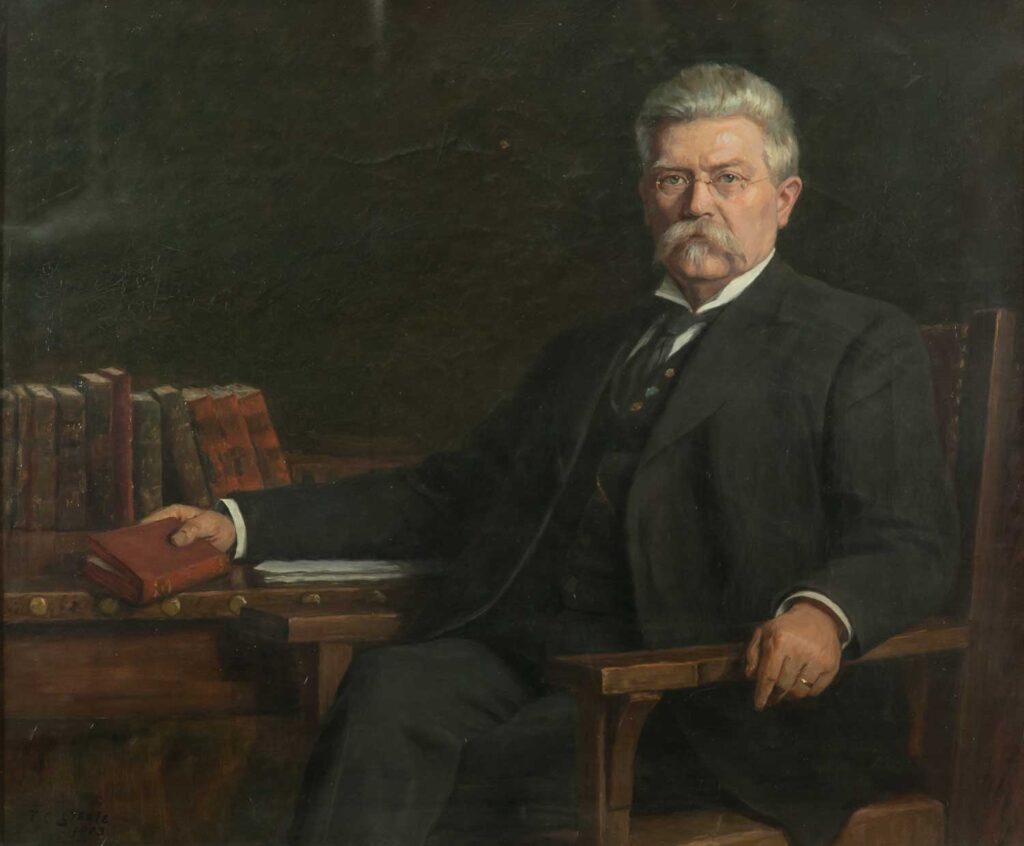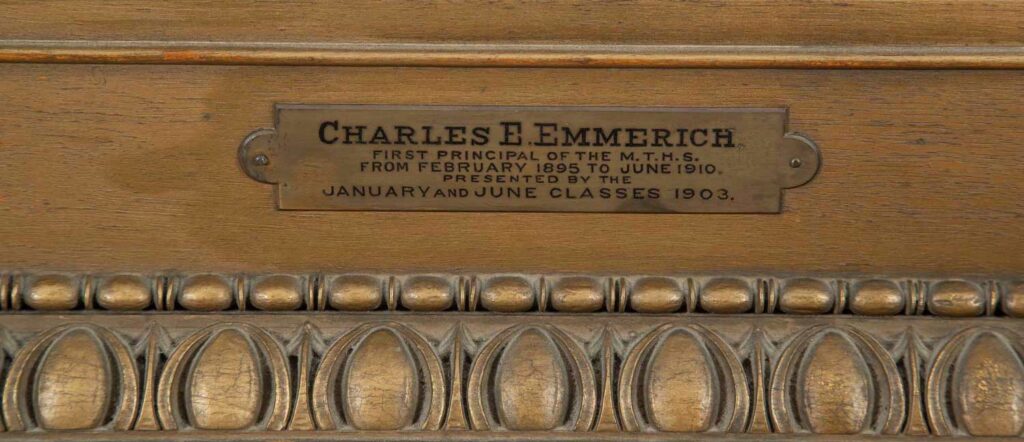
Theodore Clement Steele, American, 1847–1926
1903
Oil on canvas
125.10 cm x 105.41 cm | 49.25 in x 41.25in
Framed: 158.12 cm x 137.80 cm | 62 1/4 in x 54 1/4 in
Signed and dated lower left, T.C. Steele / 1903
From the collection of Indianapolis Public Schools – used by permission
Charles E. Emmerich (1845 – 1911) was the first principal of the Manual Training High School in Indianapolis. The school was renamed Charles E. Emmerich Manual Training High School in 1916 in his honor. He was principal from the time the school opened (February, 1895) until his resignation (due to his health) at the end of the school year in June 1910.¹ The school carries the name Emmerich Manual High School to this day.
Manual plays an important part of Indianapolis public education. From 1864 – 1916, there were three high schools opened under the Indianapolis School District (Shortridge, Manual, Arsenal Technical). All three schools, Shortridge, Manual and Arsenal Technical still exit and provide education today.
- Present day Shortridge was originally known as Indianapolis High School (opened in 1864 and renamed Shortridge in 1881). Shortridge is the oldest free public high school in Indiana, and was listed in the National Register of Historic Places, September 15, 1983, ref# 83000078.
- Present day Emmerich Manual was originally called Industrial Training School (1899) when created by the General Assembly in 1895, and the name was changed to Manual Training High School in 1899, and Charlies E. Emmerich Manual Training High School in 1916.
- Arsenal Technical has retained its original name (commonly referred to as “Tech”), and remains the third oldest high school in Indianapolis (of which it is the second oldest high school to still operate at its original location). Listed on the National Register of Historic Places, May 19, 1976, Ref# 76000034.

Charles Emmerich was a noted educator, leader and builder of modern schools, serving the education system for over thirty-seven years.¹ His role in Indianapolis was significant as a both a leader of progressive education and as the first principal of Manual, a co-ed school. The education curriculum included courses in science, literary, and manual training departments that taught the use of tools, cooking and sewing, as well as athletic programs, clubs and theatrical productions. Charles Emmerich was the first to declare the purpose of this manual training: “discipline of the Mind and Hand.”
Also among his many contributions to Manual Training High School was the beginning of an athletic program, the organization of the first orchestra, instituting of Visitors’ Day at the end of each semester, planning of the first anniversary celebration and introducing the advanced report card, a system by which the students were graded every six weeks.⁶
Charles Emmerich came to the United States in 1865, at 21 years old, and unable to find employment, he enlisted in the regular army. While traveling from New Mexico to Ft. Leavenworth, Kansas, he experience an illness that became serious and was left at a Kansas farmhouse. As his term of army service was about to expire, a Kansas farmer, who recognized that the private soldier was a man of more than ordinary education, hired Emmerich to teach at a district school. Charles Emmerich obtained a diploma in the teaching term and for 41 years it proudly hung on his study wall which he always pointed to with pride”¹.
Emmerich saw a casual advertisement in a newspaper that caused him to come to Madison, Indiana in 1869 where he taught in the district schools. While in Madison, he wrote an article on “compulsory education”, which was published by the Indianapolis Daily Journal and caught the eye of Abraham C. Shortridge, then superintendent of the public schools of Indianapolis. Mr. Shortridge corresponded with Professor Emmerich and invited him to a conference that resulted in a meeting where Professor Emmerich would teach join the faculty of the Indianapolis High School, as a teacher of Greek, Latin and German. Indianapolis High School later became Shortridge High School and Emmerich held this positon for 19 years, most of which was teaching German.¹

Due to overcrowding at the only high school in Indianapolis (Shortridge), school board members recognized the need for a high school and created High School #2 on the Southside. The board also gave their approval of a new type of curriculum known as the “Manual Training Movement” that taught practical hand skills along with traditional classes.
When “High School #2” (established in School No. 8 on Virginia Avenue) in Indianapolis was organized in August, 1892, (the forerunner of Manual Training High School). Mr. Emmerich was named principal of High School #2 and held this positon until February, 1895, when it was named Manual Training High School of which he became the first principal.
While principal at Manual, Charles Emmerich founded the school orchestra, which became a feature in the school.¹ Manual remained a city leader in their music programs through the mid 1970’s. The orchestra was an extension of his love for music.
Emmerich was a long time singer in the Indianapolis Maennerchor formed by a group of Germans who immigrated to Indianapolis in 1848, and president for several years.² The Maennerchor was the oldest continuously existing male choir in the United States; and the 164 year legacy ended with their last performance on May 30, 2018 in Indianapolis.
Mr. Emmerich also is credited with inception of the idea of trade schools and lobbied for a third high school on the grounds of the former U.C. Civil War arsenal (1864 – 1903) on the near eastside of Indianapolis. The arsenal had closed and became vacant following the Spanish-American War. This third Indianapolis high school would also provide “manual training”, and help alleviate the overcrowding of Shortridge and Manual. This new high school became the present day Arsenal Technical “Tech” High School and was listed on the National Register of Historic Places, May 19, 1976.
The manual training method received national recognition, the Honorable William E. Dodge of New York said about his visit in 1897;
“Among the pleasant and profitable incidents of my trip to Indianapolis, I shall always remember my visit to the Industrial Training School. I have had some knowledge of these schools in various sections of the country, and I know of no one more widely equipped, more cheerful or apparently better work than the one in Indianapolis.”³
President James H. Smart of Purdue University in Lafayette, Indiana, known as “the engineers’ president”, said in the same year of 1897;
“Those of your graduates who have come to Purdue are first-class men, and your equipment certainly equal that of any manual training school in the country. In addition, I have reason to know that the greatest of care has been exercised in arranging the course of study and in the selection of the faculty.”³
Indianapolis public schools had the influence of many of Germany’s 48 ers, who immigrated to Indianapolis and became successful. One of which was Clemens Vonnegut, Sr. who helped form the Indianapolis Turngemeinde.⁴ These German Turners in America endorsed gymnastics for attaining physical fitness as part of their educational emphasis with the motto “a sound mind in a sound body”.⁵ (sometimes referenced as “a strong mind in a strong body, i.e. Clemens Vonnegut, Sr.”)⁴. Vonnegut was also a member of the Indianapolis Maennerchor and a prominent businessman. He was active with his influence and beliefs about education, and there is strong reason to believe with several of the same local affiliations such as the Maennerchor and German heritage, Vonnegut and Emmerich exchanged education and philosophical ideas.
Principal Emmerich created an athletic program at Manual that would have the same rigor as academic curriculum and is well documented;
“Mr. Emmerich made it incumbent on the boys of athletic tendencies that to enter into the games and sports the boys should keep up in scholarship. In this way he made scholarship an incentive to the aspirant for athletics. The boys called him Caesar, recognized him as an imperial authority not to be questioned. At the same time he had the devoted attachment of all who were under his firm but just rule.”¹
Principal Emmerich was clearly a respected and beloved man, he is described in a history book on Emmerich Manual High School 1895 – 1969;
“Mr. Emmerich’ s success in building up the school is due in no small measure to his great popularity among teachers and students. The Alumni affectionately refer to him as the “Grand Old Man” of their Alma Mater.”⁶
An immigrant from Germany, Charles Emmerich was born in Coblentz, on the Rhine, Germany in August 1845. (spelled Coblentz before 1926, situated on both banks of the Rhine). Mr. Emmerich died at his home at 1429 East Vermont Street in Indianapolis at twelve o’clock Tuesday, June 6, 1911 at the age of 65. Charles Emmerich is buried in Crown Hill Cemetery, Indianapolis, Section 48, Plot 735.
His son Max Phillip Emmerich (1879 – 1956) was an Olympic gold medalist, winning the triathlon, which was a mix of gymnastics and athletics in the 1904 Games in St. Louis, Missouri, USA. Max Emmerich died at the age of 77 years. He was employed for 25 years at Vonnegut Hardware Company. Mr. Emmerich is buried in Crown Hill Cemetery in Indianapolis, same plot as his father Charles Emmerich.⁷
¹ The Indianapolis News, (Indianapolis, Indiana), 06 June 1911, Tuesday, pg. 1, “Charles E. Emmerich, Noted Educator, Dead”
²Indianapolis Maennerchor Records, 1866-1990, Ruth Lilly Special Collections & Achieves, IUPUI, http://www.ulib.iupui.edu/collections/german-american/mss040
³Mind and Hand, Vol III. No. 1. Indianapolis, Indiana, May 1897, pg. 7, 8, Indianapolis Public Library Digital Collections
⁴Kurt Vonnegut Museum & Library, Vonnegut Family History, Clemens Vonnegut https://www.vonnegutlibrary.org/vonnegut-family-history-clemens-vonnegut/
⁵Sports in American History: From Colonization to Globalization; Gems, Gerald R, PhD, Borish, Linda J., Pfister, Gertrud, PhD, first edition, ISBN-13: 978-0736056212, Human Kinetics, August 7, 2008
⁶Emmerich Manual High School, A History, 1895-1969, pg. 11 Carolyn Griffin, Department of English, 1969, IUPUI School of Liberal Arts, IUPUI Digital Library http://ulib.iupuidigital.org/cdm/ref/collection/NOS/id/1553
⁷The Indianapolis Star (Indianapolis, Indiana), 01 July 1956, pg. 50, “M.P. Emmerich Dies: Once a Track Star”
